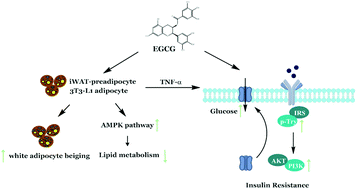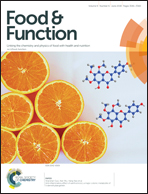EGCG stimulates the recruitment of brite adipocytes, suppresses adipogenesis and counteracts TNF-α-triggered insulin resistance in adipocytes†
Abstract
The global rise in obesity and type 2 diabetes has precipitated the need for therapeutic intervention in the arsenal against adiposity. (−)-Epigallocatechin-3-gallate (EGCG), a major nutraceutical component of green tea, has been regarded as a nutraceutical that has powerful antioxidant and anti-obesity bioactivities. In the present study, we showed that EGCG alleviates intracellular lipid accumulation markedly, and the inhibitory effect was largely limited to the early stage of adipocyte differentiation. Consistently, EGCG notably evoked the phosphorylation of AMPK and ACC and blunted the key enzymes of de novo lipogenesis. Interestingly, EGCG elicited iWAT-preadipocyte-derived mature white adipocyte beiging via activating thermogenic gene Ucp1 expression and mitochondrial biogenesis. Furthermore, our results also revealed that EGCG attenuated insulin signaling pathway blockage induced by TNF-α through the abrogation of redox imbalance and mitochondrial dysfunction. These findings indicate that EGCG is capable of suppressing adipogenesis and evoking white adipocyte beiging and therefore it may potentially serve as a novel approach to combat obesity.



 Please wait while we load your content...
Please wait while we load your content...